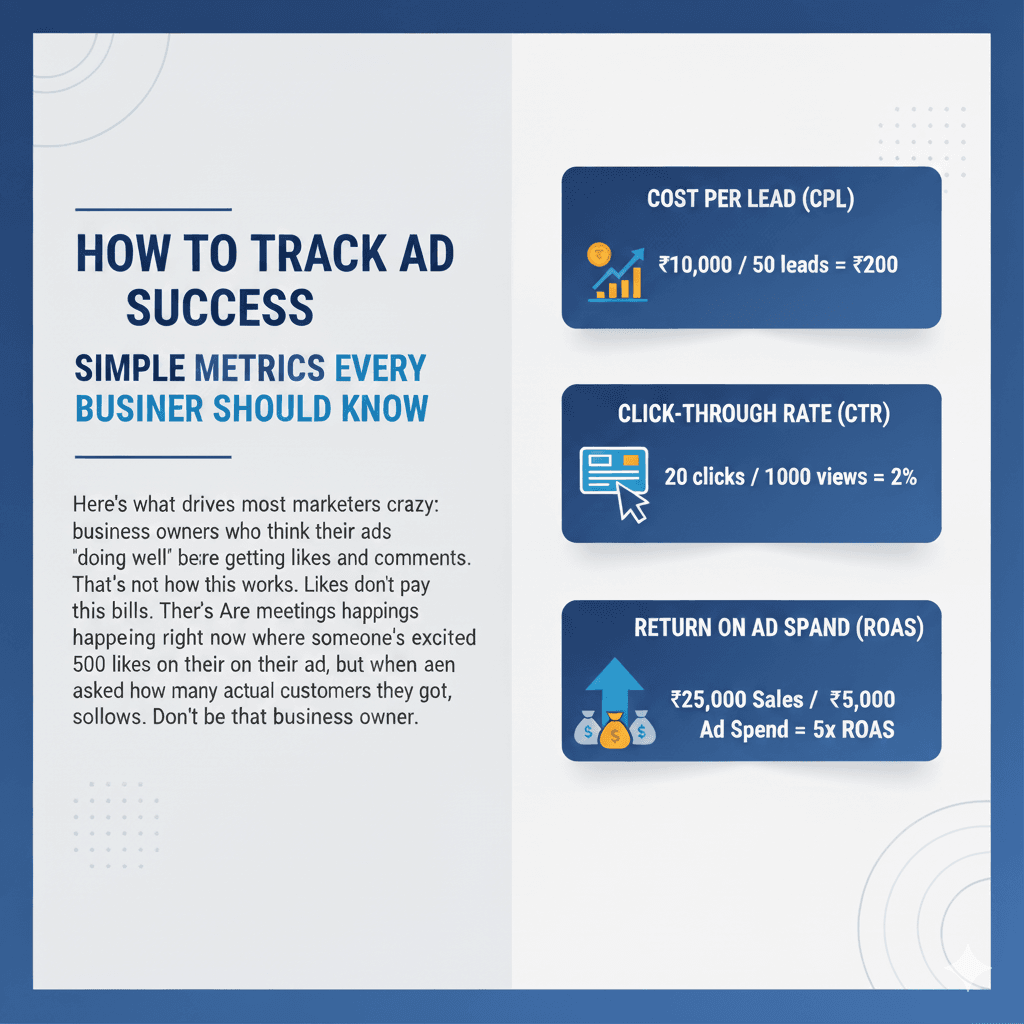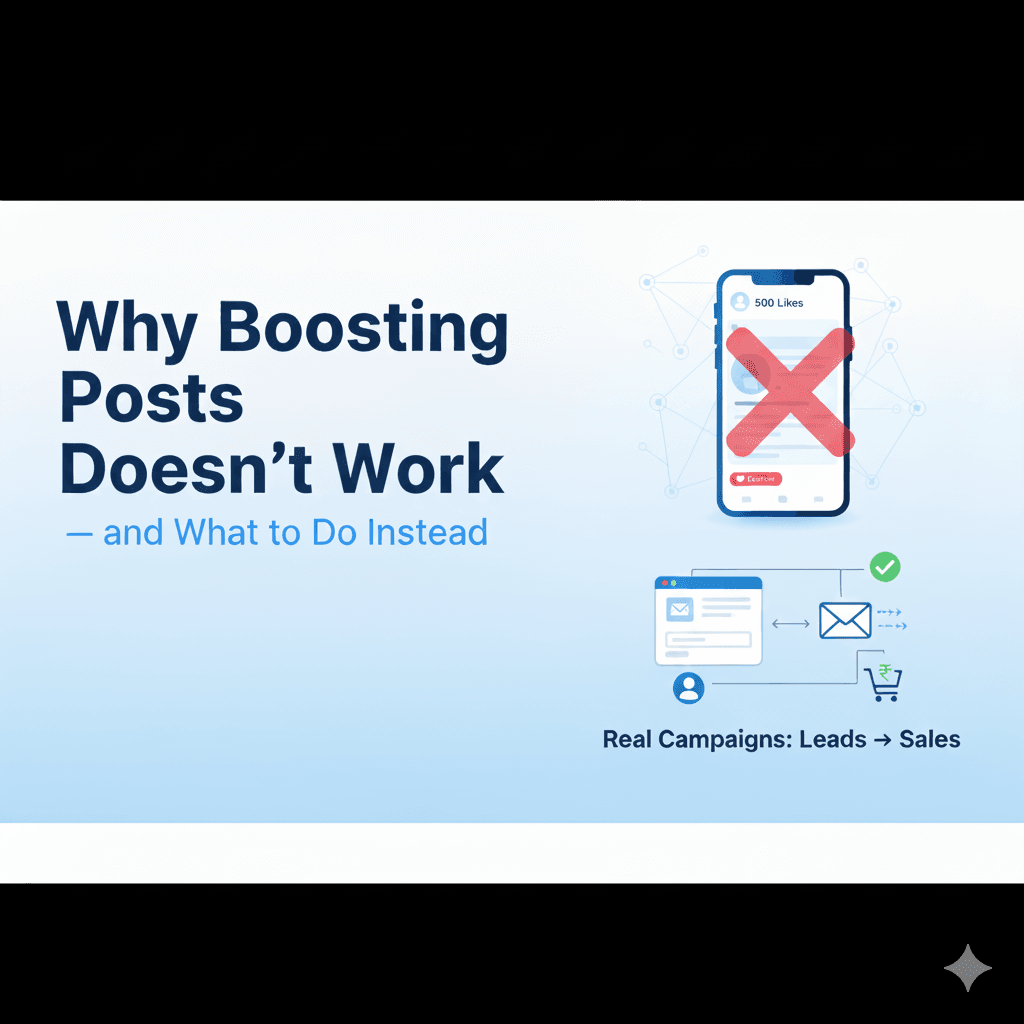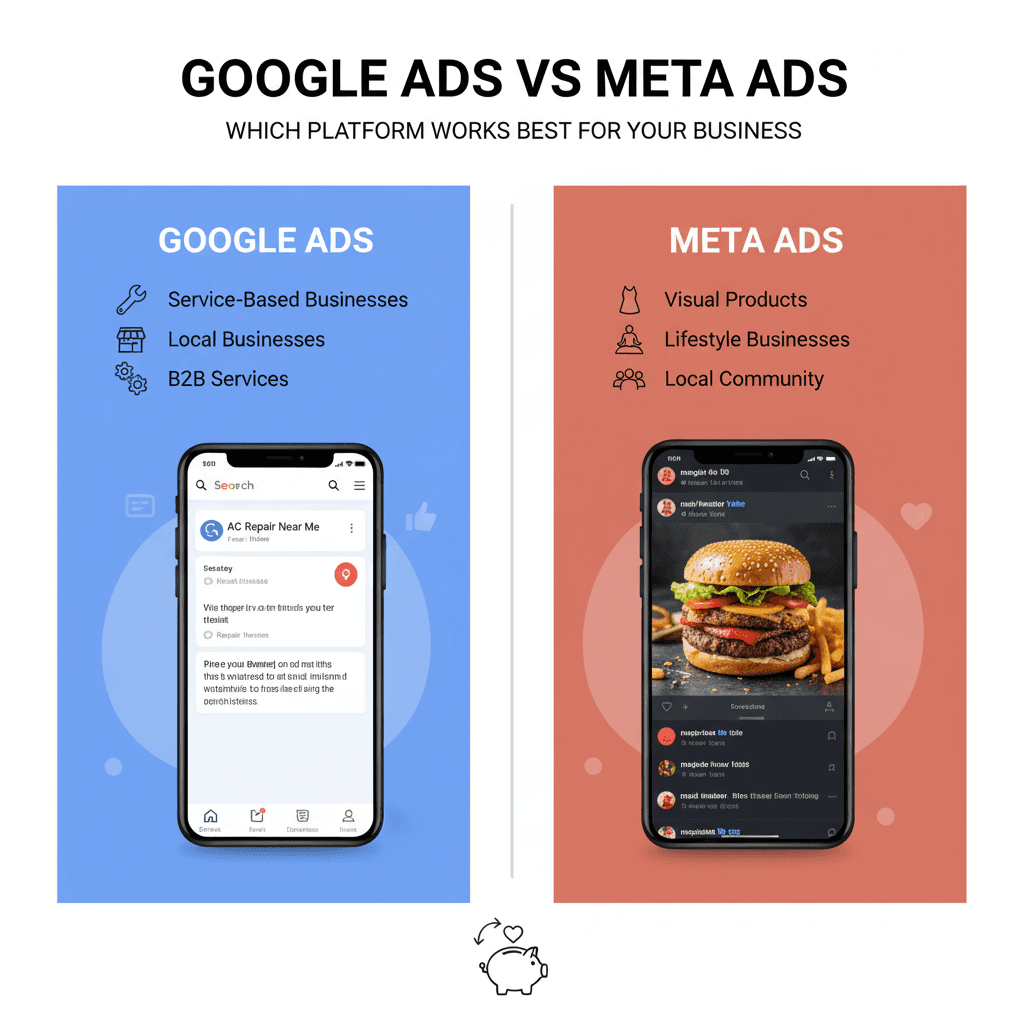How to Track Ad Success: Simple Metrics Every Business Owner Should Know
Fri Sep 26 2025
·3 min read

- How to Track Ad Success: Simple Metrics Every Business Owner Should Know
- The Numbers That Actually Matter
- Cost Per Lead (CPL) - Your Reality Check
- Click-Through Rate (CTR) - Your Attention Grabber
- Return on Ad Spend (ROAS) - The Only Number Bank Accounts Care About
- Conversion Rate - Your Website's Report Card
- Impressions vs Reach - Understanding Your Audience
- The Vanity Metrics Trap
- What About Offline Sales?
- Tools Actually Needed
- Making Decisions with Data
- Common Tracking Mistakes
- Building a Simple Tracking System
- The Bottom Line
How to Track Ad Success: Simple Metrics Every Business Owner Should Know
Here's what drives most marketers crazy: business owners who think their ads are "doing well" because they're getting likes and comments.
That's not how this works. Likes don't pay the bills.
There are meetings happening right now where someone's excited about 500 likes on their ad, but when asked how many actual customers they got, silence follows. Don't be that business owner.
The Numbers That Actually Matter
Advertising metrics can get complicated fast. But understanding what's working doesn't require a marketing degree. It just needs tracking the right stuff.
Marketing consulting companies love throwing around fancy terms, but here are the basics that actually affect the bottom line.
Cost Per Lead (CPL) - Your Reality Check
This one's simple. How much does it cost for each person who shows interest in the business?
Say ₹10,000 was spent on ads and 50 people filled out contact forms. The CPL is ₹200.
Is that good? Depends on the business. Selling something worth ₹50,000 makes ₹200 per potential customer pretty reasonable. Selling ₹500 items? That's a problem.
Some businesses celebrate getting "cheap leads" at ₹50 each, then realize these leads never buy anything. Meanwhile, other businesses pay ₹500 per lead but close 30% of them. Guess who's making more money?
Marketing consulting agency experts always tell clients to focus on lead quality, not just quantity. Cheaper isn't always better.
Click-Through Rate (CTR) - Your Attention Grabber
This shows how many people actually clicked on an ad after seeing it.
If 1000 people see an ad and 20 click it, that's a 2% CTR.
Here's the thing – terrible CTR (under 1%) usually means the ad is boring. People scroll right past it. Better headlines, better images, or better offers are needed.
But don't obsess over CTR either. Some ads have amazing CTR but bring in terrible customers who never buy anything.
Return on Ad Spend (ROAS) - The Only Number Bank Accounts Care About
This is the big one. For every rupee spent on ads, how many rupees come back?
Spent ₹5,000 on ads and made ₹25,000 in sales? The ROAS is 5x. That means every rupee spent brought back 5 rupees.
Performance marketing agency professionals typically aim for at least 3x ROAS, but this varies wildly by industry. Restaurants might be happy with 2x because they get repeat customers. Luxury services might need 10x to make the numbers work.
Here's what most people mess up – they only count immediate sales. If someone buys again next month because of that ad, that counts too. Factor in customer lifetime value, not just the first purchase.
Conversion Rate - Your Website's Report Card
Getting clicks is great. Getting those clicks to actually do something useful is better.
If 100 people click an ad and 5 buy something, that's a 5% conversion rate.
Low conversion rate usually means one of two things: wrong audience or broken website. Sometimes ads attract the right people, but landing pages are confusing or checkout processes are nightmares.
Top digital marketing companies obsess over conversion rates because improving this number is often easier than getting more traffic.
Impressions vs Reach - Understanding Your Audience
Impressions = how many times an ad was shown Reach = how many different people saw it
Having 10,000 impressions but only 2,000 reach means the same people are seeing the ad 5 times each. Sometimes that's good (reinforcement), sometimes it's bad (annoying people).
Some campaigns show the same person an ad 20+ times. That's not marketing, that's harassment.
The Vanity Metrics Trap
Engagement rates, video views, brand awareness – these sound important, but they don't directly put money in pockets.
This doesn't mean ignore them completely. Social proof matters. But when choosing between an ad that gets 1000 likes and one that generates 10 sales, pick the sales every time.
Best digital marketing company strategies focus on metrics that connect to revenue, not just metrics that feel good.
What About Offline Sales?
"But customers call or visit stores – how can that be tracked?"
Great question. Use promo codes. Ask new customers how they heard about the business. Track phone calls if possible. Most ad platforms can track phone calls from ads now.
The point is connecting ad spending to actual business results, even if tracking isn't perfect.
Tools Actually Needed
Don't overthink this. Google Ads and Facebook already show most of these numbers. Google Analytics is free and handles the rest.
Expensive tracking software isn't needed when starting out. The built-in tools work fine for most businesses.
Marketing consultants might recommend fancier tools later, but get the basics working first.
Making Decisions with Data
Track these numbers weekly, not daily. Daily numbers jump around too much to be useful. Monthly reviews help spot trends and make real improvements.
If CPL is going up, test new ad creative. If ROAS is dropping, look at landing pages or targeting. If CTR is low, ads probably need work.
Performance marketing agency teams make these adjustments constantly. It's not about setting up perfect campaigns from day one – it's about continuously improving based on what the numbers reveal.
Common Tracking Mistakes
Many businesses track everything except what matters. They know their video completion rates but can't tell you if ads are profitable.
Others check metrics once per month, then wonder why their campaigns burned through budget on poor performance. Weekly check-ins catch problems before they get expensive.
Some focus only on the cheapest metrics instead of the most valuable ones. A ₹50 lead that never buys is worthless compared to a ₹500 lead that becomes a ₹10,000 customer.
Building a Simple Tracking System
Start with the basics: CPL, ROAS, and conversion rate. These three numbers tell most of the story about whether advertising is working.
Set up simple spreadsheets or use the reporting tools already built into ad platforms. Don't invest in complex systems until the simple ones are working properly.
Performance marketing agency Kerala teams often recommend starting simple and adding complexity only when businesses prove they can handle the basics consistently.
The Bottom Line
Stop tracking things that don't matter. Start tracking things that affect bank accounts.
Becoming a data scientist isn't necessary. Just know if advertising is making money or costing money. These key metrics tell that story clearly.
Focus on getting profitable first, then worry about getting fancy with tracking and optimization. The businesses that succeed quickly identify what's working and do more of it.
Marketing consulting companies that get results understand this fundamental truth: vanity metrics feel good, but profit metrics pay the bills. Choose which numbers to chase wisely.




